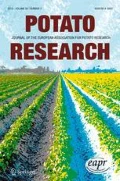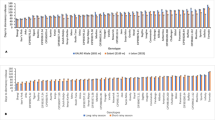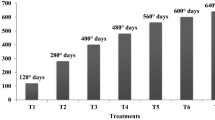Summary
In the Negev area of Israel potatoes are grown in two seasons of the year: spring and autumn. Locally grown seed of cv. Up-to-Date prepared for the autumn season are grown in the spring under high-temperature conditions during the last part of the growth period. The response to storage temperature treatments consisted of different degrees of sprouting. Temperatures that encouraged bud development (12–22°C) shortened the dormant period of the tubers by about a month, and usually there is clear apical dominance. However, increasing length of the apical bud was positively correlated with storage temperature. Partial loss of apical dominance was obtained when the tubers were held at a low temperature (4°C) for at least two months after lifting. After transfer of the tubers to high temperatures for another month, there were 3 or 4 sprouts per tuber. The physiological age of seed tubers developing in the semi-arid region is discussed.
Zusammenfassung
-
1.
Im Negevgebiet in Israel werden Kartoffeln zweimal im Jahr gepflanzt: Frühling und Herbst. Knollen der Sorte Up-to-Date aus einiger Herkunft, die für die Herbstpflanzung vorgesehen sind, werden im Frühling unter hohen Temperaturen gegen Ende der Wachstumsperiode produziert. Eine Lagerung nach der Ernte unter optimalen Temperaturen für die Keimentwicklung verkürzt die Ruheperiode auf ungefähr einen Monat und führt zu einer Keimung nur der apikalen Knospe. Das führt zu weniger Stengeln/Einheit, weniger Knollen und folglich geringerem Ertrag.
-
2.
Die Untersuchungen wurden durchgeführt, um den Einfluss der Lagertemperaturen auf die Keimung von Pflanzkartoffeln zu studieren, die im Frühjahr in einem semiariden Gebiet gewachsen waren, um im Herbst in einem 2-Fruchtsystem verwendet zu werden. Folgende Behandlungen wurden durchgeführt: a) Einfluss der Lagertemperaturen von 4, 8, 12, 16 und 22°C (beleuchtet) auf die Ruheperiode und das Keimwachstum (Abb. 1 und Tabelle 1) und b) Keimung von Knollen, die bei 4°C 2, 4, 6, 8 und 10 Wochen im Dunkeln gelagert und dann in eine beleuchtete Klimakammer bei 22°C gebracht wurden (Abb. 2, 3, 4, 5 und Tabelle 2). Die Versuche wurden über eine Lagerperiode von 12 Wochen durchgeführt.
-
3.
Die Lagertemperatur hatte verschiedene Einflüsse auf die Keimung. Temperaturen, die die Keimentwicklung förderten (12–22°C), verkürzten die Ruheperiode der Knollen um ungefähr 4 Wochen und führten gewöhnlich zu einer eindeutigen apikalen Dominanz. Der Beginn des apikalen Keimwachstums wurde bereits kurze Zeit nach der Knollenernte beobachtet, der Längenzuwachs des Keims war positiv korreliert mit der Lagertemperatur. Lagerung bei einer tiefen Temperatur (4°C) für mindestens 2 Monate führte zu einem teilweisen Verlust der apikalen Dominanz. Nach der überführung der Knollen in eine höhere Temperatur (22°C) für einen weiteren Monat, entwickelten sich 3 oder 4 Keime/Knolle, obwohl die Knollen chronologisch jung waren.
-
4.
Entsprechend den Abläufen des physiologischen Alters waren Knollen, die zwei Monate nach der Ernte bei hohen Temperaturen gelagert waren, in einem ‘jugendlichen Zustand’ (Ein-Keim-Stadium) und jene, gelagert 3 Monate bei tiefen Temperaturen, im ‘richtigen Alter’ für das Auspflanzen. Die Ergebnisse unterstützen die These, dass Umweltfaktoren während der Wachstumsperiode, das physiologische Alter einer Knolle beeinflussen.
Résumé
-
1.
En Israël, dans la région du Negev, on cultive les pommes de terre en deux saisons de l'année: printemps et automne. Des semences de production locale de la variété Up-to-Date, préparées pour la saison d'automne ont été cultivées au printemps, avec de hautes températures en fin de végétation. Après récolte, la conservation des tubercules à température optimale pour la germination raccourcit la période de dormance à environ un mois, et dans ces conditions, seul le germe apical se développe. Cela entraine un nombre de tiges plus faible par unité de surface, moins de tubercules, et par suite des récoltes plus faibles.
-
2.
L'étude a été entreprise pour rechercher l'influence des températures de conservation, sur la germination de semences poussant au printemps en région semi-aride, pour être utilisées en automne dans un système à deux cultures par an. Les traitements ont eu pour objet: a) l'effet des températures de conservation de 4, 8, 12, 16 et 22°C (avec éclairage) sur la durée de la dormance et sur la croissance des germes (figure 1 et tableau 1); b) la germination de tubercules conservés à l'obscurité à 4°C pendant 2, 4, 6, 8 et 10 semaines et transférés ensuite en germoir éclairé à 22°C (figures 2, 3, 4 et 5; tableau 2). Les essais ont été menés sur une période de conservation de 12 semaines.
-
3.
Les températures de conservation ont eu différents effets sur la germination. Les températures favorables au développement des germes (12–22°C) ont raccourci la période de dormance de 4 semaines environ et ont en général conduit à une dominance apicale marquée. Le début de croissance du germe apical est intervenu peu après la récolte du tubercule, son allongement étant corrélé positivement avec la température de conservation. Une perte partielle de la dominance apicale a été obtenue en conservant les tubercules à basse température (4°C) après la récolte, pendant au moins 2 mois. Après passage des tubercules à haute température (22°C) pendant un mois supplémentaire, 3 ou 4 germes se sont développés sur chaque tubercule, bien que ces tubercules soient chronologiquement jeunes.
-
4.
Selon la succession des stades physiologiques, les tubercules conservés à haute température étaient dans un ‘état juvénile’ (stade d'l germe), deux mois après la récolte, et ceux conservés à basse température étaient au bout de trois mois à un ‘âge correct pour être replanté’. Les données présentées accréditent la thèse de l'influence des facteurs de l'environnement durant la période de végétation sur l'âge physiologique du tubercule.
Similar content being viewed by others
References
Bodlaender, K. B. A., C. Lugt & J. Marinus, 1964. The induction of second growth in potato tubers.Eur. Potato J. 7: 57–71.
Burton, W. G., 1968. Work at Ditton laboratory on the dormancy and sprouting of potatoes.Am. Potato J. 45: 1–11.
Davidson, T. M. W., 1958. Dormancy in the potato tuber and the effects of storage conditions on initial sprouting and on subsequent sprout growth.Am. Potato J. 35: 451–465.
Goodwin, P. B., 1963. Mechanism and significance of apical dominance in the potato tuber. In: J. D. Ivins & F. L. Milthorpe (Eds.), The growth of the potato. Butterworths, London, pp. 63–71.
Goodwin, P. B., 1967. The control of branch growth on potato tubers. II. The pattern of sprout growth.J. exp. Bot. 18: 87–99.
Iritani, W. M., 1968a. Factors affecting physiological aging (degeneration) of potato tubers used as seed.Am. Potato J. 45: 111–116.
Iritani, W. M., 1968b. The effect of storage temperature and source on productivity of Russet Burbank seed.Am. Potato J. 45: 322–326.
Kawakami, K., 1962. The physiological degeneration of potato seed tubers and its control.Eur. Potato J. 5: 40–49.
Krijthe, K., 1962. Observations on the sprouting of seed.Eur. Potato J. 5: 316–332.
Sadler, E. M., 1961. Factors influencing the development of sprouts of the potato. Ph.D. thesis, University of Nottingham, England.
Susnoschi, M., 1974. Tuber yield in potatoes as related to number of stems per plant.Agric. Res. Orgn Israel, Inst. Field Garden Crops, trienn. Rep., pp. 125–126. (Abstr.).
Susnoschi, M., 1976. The effect of high temperatures during the growth period on the dormancy of potato seed tubers. Ph.D. thesis, Hebrew University of Jerusalem, Israel (Hebrew, English summary.)
Susnoschi, M., J. Krikun & Z. Zuta, 1976. Trial of common potato varieties in relation to their susceptibility toVerticillium wilt.Potato Res. 19: 323–334.
Toosey, R. D., 1959. Control of sprout numbers in main crop potatoes.Agric. London. 66: 346–350.
Toosey, R. D., 1963. The influence of sprout development at planting on subsequent growth and yield. In: J. D. Ivins & F. L. Milthorpe (Eds), The growth of the potato. Butterworths, London, pp. 79–95.
Author information
Authors and Affiliations
Additional information
Contribution from the Agricultural Research Organization, Beit Dagan, Israel 1979 Series, No 300.
Rights and permissions
About this article
Cite this article
Susnoschi, M. Seed potato quality as influenced by high temperatures during the growth period. 1. Effect of storage temperature on sprout growth. Potato Res 24, 371–379 (1981). https://doi.org/10.1007/BF02357319
Accepted:
Issue Date:
DOI: https://doi.org/10.1007/BF02357319




